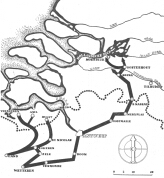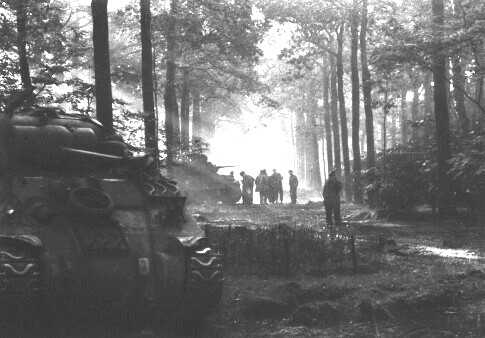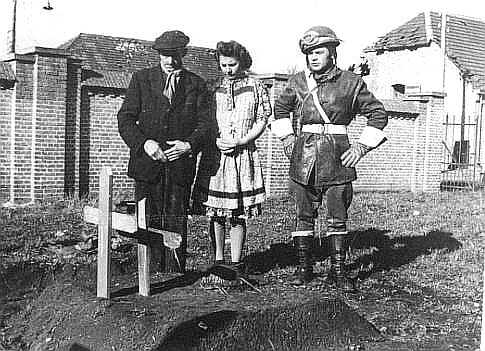
click on map to enlarge
On Sunday, the 1st of October, the Belgian village of Zondereigen was captured. The Poles took their position on the northside of the village to continue the march the next day, but at dawn the Germans took the initiative.
They attacked with infantry, supported by S.P. artillery and a dangerous situation arose. Around noon the Poles received support from aircraft, but they had great trouble to advance that day. In the hinterland also great damage was done by artilleryfire from both sides. Many buildings, like farmhouses, 2 churches and a townhall were shot on fire.
 Polish Sherman tank crossing the Belgian-Dutch frontier, 3 October 1944
Polish Sherman tank crossing the Belgian-Dutch frontier, 3 October 1944
The next day, October 3, two battlegroups started to capture the villages of Baarle-Nassau and Baarle-Hertog. The latter is a Belgian enclave on Dutch territory, situated within the borders of Baarle-Nassau. The 2 battlegroups surrounded Baarle-Nassau/Hertog and at the end of the day the Polish infantry could march into the villages.
On October the 4th the Germans north of Baarle-Nassau made again a fierce counter-attack, supported by S.P. artillery and S.P. anti-tank-artillery. This attack also could be repulsed with the aid of aircrafts.
The Polish liberators of Baarle-Nassau/Hertog met an unknown strong German resistance.The material damage was very great. Most damage was caused by fire.
Twelve inhabitants lost their lives. The fighting parties as well suffered great losses. On the 3 churchyards of both Baarles 59 Poles lay buried, whereas a number of Poles victims in hospitals succumbed to their wounds.
The fight took a heavy toll of the Germans as well, for on the cemetery of Baarle-Nassau 86 Germans were buried after the liberation.
October 5. In the morning tanks and infantry started the attack on the village of Alphen. With support of airplanes the hamlets of Terover, Hondseind and Kwaalburg and the village of Alphen were conquered.
 Near castle "De Kieviet" at Baarle-Nassau.
Near castle "De Kieviet" at Baarle-Nassau.
On October 6 the Division had driven a deep wedge into the enemy's territory and this wedge hold out for 3 weeks. Because of the fact that the provisioning stopped, no further action was undertaken.
The following weeks were used to replenish the provisioning, but they didn't leave the enemy at rest. The artillery fired daily at hostile targets and the infantry patrolled deeply into the enemy's territory in order to prepare a new march.
Because the Germans shot back regularly, the Poles suffered losses and the situation remained so dangerous that the whole population of Alphen had to evacuate the village.
After the liberation there were 18 Polish wargraves on the churchyard of Alphen. In the surroundings of Alphen also 9 Poles were killed in this period.
Not before October 27 the front moved again. The 1st Polish Armoured Division started a new action in order to liberate the southern part of the Netherlands.
See: [The liberation of Breda]
 Parish Cemetery at Alphen.
Parish Cemetery at Alphen.
Graves of the brothers Włoch
Literature:
In Dutch:
Shortly after the liberation J. Festraets wrote a good booklet titled: Baarle in de Branding A description of the liberation of Baarle-Nassau and Baarle-Hertog.
In the English language:
With the tanks of the 1st Polish Armoured Division written by
K. Jamar.
This book was published in 1946 by H.L. Smit & Zn. at Hengelo, the Netherlands
|



